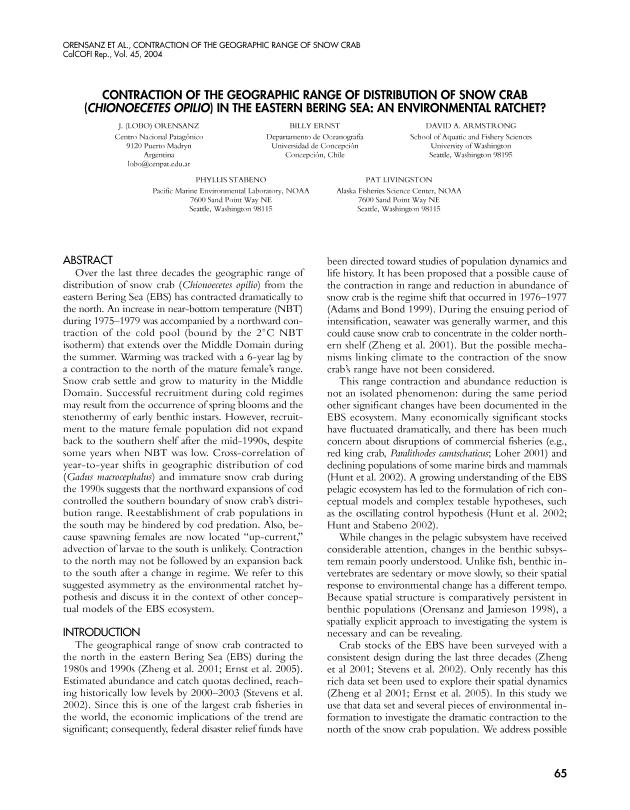Artículo
Contraction of the geographic range of distribution of snow crab (Chionoecetes opilio) in the eastern Bering Sea: An environmental ratchet?
Fecha de publicación:
08/2005
Editorial:
Scripps Institution of Oceanography
Revista:
California Cooperative Oceanic Fisheries Investigations Reports
ISSN:
0575-3317
Idioma:
Inglés
Tipo de recurso:
Artículo publicado
Clasificación temática:
Resumen
Over the last three decades the geographic range of distribution of snow crab (Chionoecetes opilio) from the eastern Bering Sea (EBS) has contracted dramatically to the north. An increase in near-bottom temperature (NBT) during 1975–1979 was accompanied by a northward contraction of the cold pool (bound by the 2°C NBT isotherm) that extends over the Middle Domain during the summer. Warming was tracked with a 6-year lag by a contraction to the north of the mature female's range. Snow crab settle and grow to maturity in the Middle Domain. Successful recruitment during cold regimes may result from the occurrence of spring blooms and the stenothermy of early benthic instars. However, recruitment to the mature female population did not expand back to the southern shelf after the mid-1990s, despite some years when NBT was low. Cross-correlation of year-to-year shifts in geographic distribution of cod (Gadus macrocephalus) and immature snow crab during the 1990s suggests that the northward expansions of cod controlled the southern boundary of snow crab’s distribution range. Reestablishment of crab populations in the south may be hindered by cod predation. Also, because spawning females are now located “up-current,” advection of larvae to the south is unlikely. Contraction to the north may not be followed by an expansion back to the south after a change in regime. We refer to this suggested asymmetry as the environmental ratchet hypothesis and discuss it in the context of other conceptual models of the EBS ecosystem.
Archivos asociados
Licencia
Identificadores
Colecciones
Articulos(CCT-CENPAT)
Articulos de CTRO.CIENTIFICO TECNOL.CONICET - CENPAT
Articulos de CTRO.CIENTIFICO TECNOL.CONICET - CENPAT
Citación
Livingston, Pat; Stabeno, Phyllis; Armstrong, David A.; Ernest, Billy; Orensanz, Jose Maria; Contraction of the geographic range of distribution of snow crab (Chionoecetes opilio) in the eastern Bering Sea: An environmental ratchet?; Scripps Institution of Oceanography; California Cooperative Oceanic Fisheries Investigations Reports; 45; 8-2005; 65-79
Compartir




